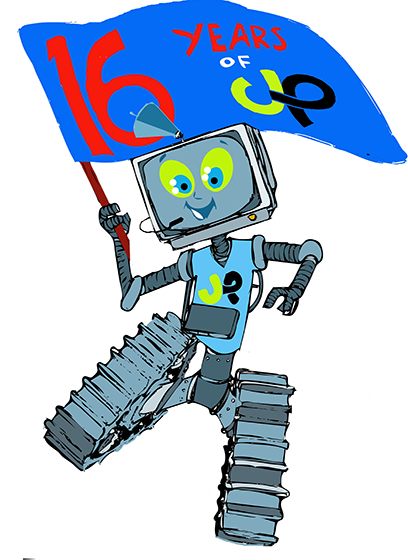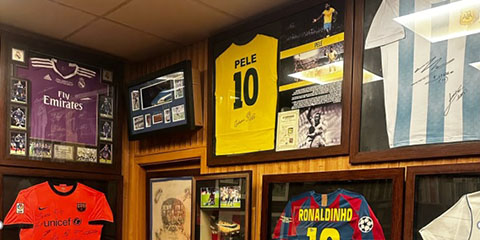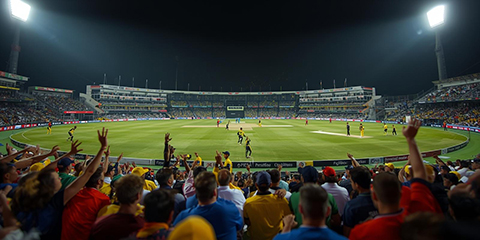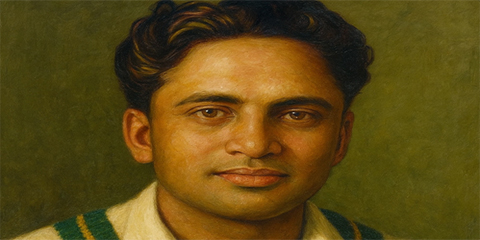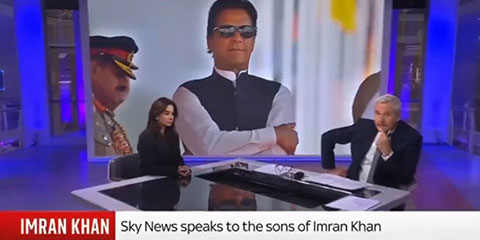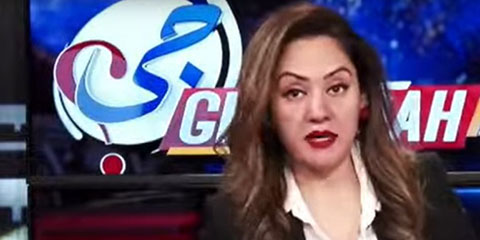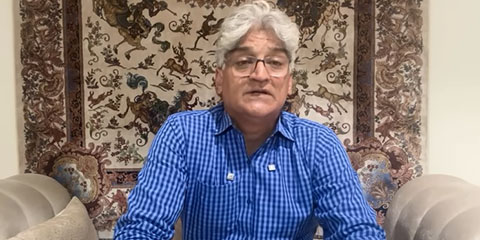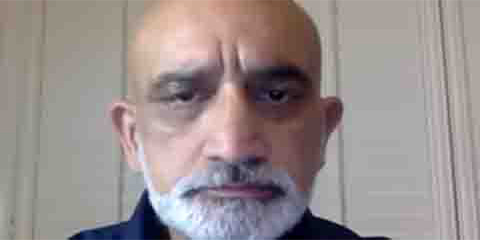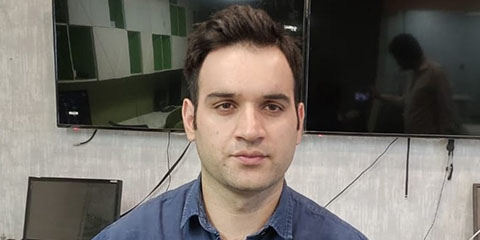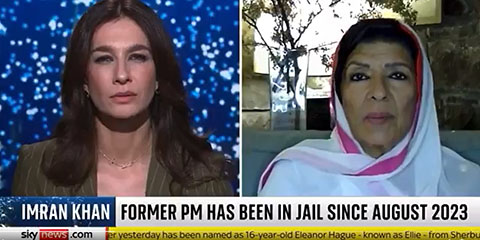How Sami Ul Hasan Burney became cricket's master of crisis communication and narrative control
JournalismPakistan.com | Published 3 months ago | Dr. Nauman Niaz (TI)
Join our WhatsApp channel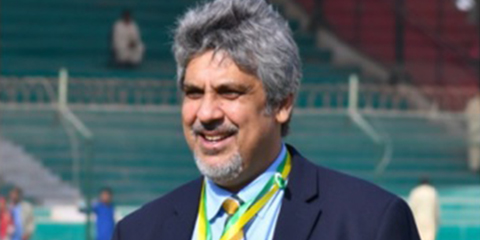
ISLAMABAD—Some men enter a newsroom softly, and some storm it. Sami Burney never walked in with hesitance; he arrived with a kind of bristling confidence, the air charged by his presence. He was the sort of journalist who treated intimidation like background noise, always there, but never enough to break his stride. There was swag in the way he confronted power, in the manner he stood at press conferences, voice pitched not in supplication but in challenge. His questions carried weight not because they were loud, but because they were sharp, piercing the armours of politicians and sports czars alike. He was an aggressor, yes, but aggression tempered by craft; his boldness was less about theatre and more about the steady conviction that truth deserved to be dragged out into daylight, however much it tried to hide.
The Evolution of a Media Management Maestro
Over time, Burney's instincts for confrontation evolved into something broader, more commanding. He became a builder of narratives, a man who knew that journalism was not only about the strike but also about the construct, the patient threading together of facts, context, and the pulse of a people. Media management became his stage, and he played it with the same verve that had defined his reporting. Pragmatic to the core, he understood when to push and when to pivot, when to amplify a voice and when to still the noise. Colleagues found in him not just a fierce journalist but a conductor, able to marshal chaos into coherence. In an age where stories often drowned under the weight of spectacle, Sami Burney stood apart, unflinching, articulate, and always cloaked in that indefinable aura which made you believe that the narrative, if told by him, could bend the room to silence.
Discovering the True Character Behind the Bravado
And yet, impressions, like headlines, are only the surface. Cover a few matches alongside him, and the picture began to acquire depth. The arrogance revealed itself as fearlessness; the brashness, as the refusal to be tamed by decorum. His copy was bold, urgent, and full of grip on his subject. He was a journalist who did not bend. Somewhere in those days of long afternoons and short deadlines, I discovered that Sami Burney was not just loud; he was brave.
The Legacy of I.H. Burney: A Journalistic Dynasty
This, after all, was his inheritance. His father, Izhar Ul Hasan Burney, I.H. Burney to all who mattered in the newspaper business was already legend by then. He had begun in 1958, when the smell of fresh print was still thick in Dawn’s newsroom, and retired in 1991 as city editor, carrying with him a reputation for robustness and principle. He had none of the compromises that time and power so often demand. Integrity was his beat, and he covered it like no one else. Unlike his son, though, he resisted the charms of the digital surge; email, computers, and their kin left him unimpressed. He remained orthodox, anchored to the familiar furniture of paper and type, and in that orthodoxy lay his own resilience. I.H. Burney occupies, and rightly so, a prized place in Pakistan’s journalism, stern, incorruptible, principled.
For 13 steady years, he held court as City Editor of Dawn, a role not so much occupied as inhabited, as though the rhythms of the metropolis and the pulse of the page were entwined in his very breath. He retired from that post not as one withdraws, but as an actor exits a scene already rendered immortal. Yet the curtain did not fall. Rather, it lifted anew. Summoned once more by the imperatives of truth and the clarion call of the printed word, Burney assumed the mantle of Editor at The Star, a post he held for over five years, guiding the paper’s voice with the firm delicacy of a conductor steering a symphony through storm and stillness. Thereafter, he lent his hand briefly, but with the weight of seasoned insight, to the editorial helm of the Herald, where his touch was no less profound for its brevity.
But Burney's spirit was not tethered by geography. As the winds of change stirred the Gulf sands, he stood among the founding architects of the Khaleej Times, a pioneer of prose beneath foreign skies. From 1977 to 1979, he stewarded that fledgling publication with the same fidelity he brought to every endeavour, planting in arid soil the first shoots of a press now flourishing.
Nor did his peers fail to notice the artistry in his reportage. In the early 1980s, the All Pakistan Newspapers Society (APNS) twice adorned him with laurels for Best Feature and English Reporting. not awards so much as acknowledgements, like the echoing applause after a particularly fine movement in a sonata. In I.H. Burney, journalism found a craftsman and a custodian—a man who did not merely report the age, but who gave it shape and voice, tuned to a finer frequency. His was a career less lived than composed
From Professional Rivalry to Unexpected Friendship
Sami was different, cut from the same cloth perhaps, but dyed in louder colours. He was resilient, yes, but also an extrovert, a charmer in newsrooms and press boxes. If he was with you, he was truly with you, loyalty as his unspoken contract. There came a time when our paths crossed in sharper ways. I was heading the PCB's media department, and Sami, still a correspondent, began spinning stories against us. We ran into each other at Gaddafi Stadium. I told him straight: he was going overboard. He paused, smiled that half-mischievous smile, and said, "That's my way. It will always be like this." I told him he would know differently if ever he worked inside this office. He winked, turned, and expressed 'You'll find out soon' before getting lost in the corridor.
Life, with its fond taste for irony, arranged it so. I left the PCB in 2001, choosing to return to medicine. In 2002, Sami arrived as the Board's General Manager of Media. We kept running into each other. The sharp edges of our exchanges softened; attitude mellowed into camaraderie. Perspectives shifted, interactivity grew warmer. We became, improbably, friends.
The True Test of Character: Support During Crisis
But the true measure of a man often waits until the moments of weakness, not strength. For me, that moment came with the diagnosis: Non-Hodgkin's Lymphoma. It was then that the harder exterior of Sami revealed what lay beneath, a malleable heart, sensitive, empathetic. He called me, his voice not the voice of a correspondent or an administrator, but of a brother. He told me that an Alpha never conceded; an Alpha could only recede, regroup, return. It was not just encouragement, it was the gift of will.
Later, when we met again in Abu Dhabi, by then he was at the ICC, he renewed that strength, cheering me up, infusing me with a determination I did not know I still carried. Our bond, once hesitant and prickly, had become something else, something that has lasted, and still lasts. Burney, the arrogant correspondent of the nineties, had revealed himself as Burney the loyalist, Burney the encourager, Burney the friend.
The Invisible Architecture of Cricket Communications
There is a certain invisibility to the work of communications. It is not the invisibility of darkness, which conceals; it is the invisibility of darning, of thread buried in cotton, of the scaffolding that holds up an edifice. You do not notice the hand that makes the stage ready, but the drama could not unfold without it.
In cricket, where the theatre is played in whites and under floodlights, and where every word is magnified in a thousand columns and broadcast scrolls, Sami Ul Hasan Burney has been this scaffolder, this architect of narrative, for nearly four decades.
Beyond the Boundary Ropes: A Different Kind of Cricket Career
He is not, as cricket's official histories often note, a batsman whose centuries were preserved in scorebooks, or a bowler whose figures are invoked in nostalgia. His runs are not in the ledgers of Wisden but in the balance sheets of trust; his wickets are not in the archives of averages but in the documents of crises defused. His game was not played between boundary ropes, but between federations and broadcasters, between media hounds and fragile reputations, between the fragility of national hope and the brute weight of global scrutiny.
And yet, to call him simply a "communications professional" is to diminish him. He is a historian who never picked up a quill, but instead, shaped stories in press releases, interviews, and crisis bulletins. He is a curator who kept the flame of Pakistan's cricketing dignity alive through some of its darkest hours. His story is the story of modern cricket's backstage, where the narrative is formed, defended, and sometimes reborn.
Dawn Newspaper Years: Building the Foundation of Sports Journalism
Before he became custodian of communications for cricket's two most tempestuous houses, the Pakistan Cricket Board (PCB) and the International Cricket Council (ICC), Burney was a raconteur. For Dawn, Pakistan's most serious broadsheet, he spent nearly 14 years charting the chaos and grandeur of Pakistan cricket. He reported bomb blasts outside hotels where foreign teams stayed; he investigated the murky waters of match-fixing when few dared name it; he trailed teams to New Delhi and Singapore, Colombo and Casablanca, finding in each stopover the pulse of a sport that carried a nation's heart.
There is a peculiar loneliness to the reporter's life. Airports at midnight, typewriters or fax machines humming into deadlines, the anxious wait outside boardrooms where administrators decide fates. In this loneliness, Burney learned both the craft of narrative and the cunning of timing. He learned what words soothe and what words inflame; what facts hold steady, what rumours spiral.
Early Career: From Golf Championships to Bridge Halls
Before the press boxes of World Cups and the manicured corridors of the ICC, there was a younger Burney, notebook in hand, tracing the margins of Pakistan's sporting map. He was in Islamabad in 1988, when the SAF Games brought a fragile fraternity of South Asia together under one flag of sport; in Karachi in 1993, watching the Omega Asian Golf Championship unfold, golf's alien stillness set against the city's restless pulse; and at bridge halls where minds, not bodies, battled for the right to Bermuda and Olympiad. Alongside reportage, he had his own education to pursue: a Bachelor of Science from the University of Karachi, the sturdy foundation before words consumed him entirely.
Later, he would step into classrooms at LUMS, designing the language of crisis for executives and future leaders, turning hard-earned scars into curriculum. His resume took on further colour, stints with ARY in the mid-2000s, then with the Multan Sultans twenty years later, lending his craft to cricket's ever-evolving theatres.
Northern Gymkhana: The Cricket Club That Shaped a Future Communications Expert
But even before the boardrooms and media zones, there was the club: Northern Gymkhana, Karachi's venerable nursery, where Burney thundered in as a fast bowler and scraped runs as a lower-order bat. It was there, from 1985 to 2002, in the dust and chatter of domestic pitches, that he first rehearsed the art of resilience that would serve him all his life. The tours he covered read now like a list of cricket's political phases: India's 1999 series that carried the fragile hope of peace, the 1996 World Cup played across a Pakistan half-shaken by insecurity, where regional pride spilled across disciplines.
In Dawn's archives, his sentences still bear the urgency of that age, when Pakistan cricket seemed always to be walking a tightrope strung between triumph and scandal. It was in these years that Burney honed the instinct that would later define him: the ability to see both the storm and the calm at once, to anticipate crisis before it arrived, and to script a way out before the first microphone was thrust in a face.
PCB General Manager of Media: Managing Cricket's Most Challenging Narratives
When he entered the Pakistan Cricket Board as General Manager of Media in 2002, the task was not simple. Pakistan cricket was still emerging from the corrosion of match-fixing allegations that had scarred the late 1990s. The team was mercurial, the administration even more so. The media's gaze was relentless, suspicion sharper than applause. His first major trial came with India's historic 2004 tour of Pakistan. For fifteen years, the world's most watched cricket rivalry had been denied to crowds on Pakistani soil. Now, when it returned, Burney was not only arranging press passes; he was curating a reunion of two estranged families before the entire cricketing world.
How do you choreograph hospitality for journalists from across the border, while ensuring narratives of suspicion did not overwhelm? How do you build space for celebration when political baggage lingers in every press box seat? The series became, as many remember, one of the warmest in memory. Crowds cheered for Sachin Tendulkar, Indian journalists wrote paeans of Lahore's hospitality, and Pakistan presented itself, at least momentarily, as a house of cricket and not conflict. Much of that choreography was Burney's invisible hand.
ICC Head of Media & Communications: Managing Global Cricket's Billion-Dollar Brand
In 2006, his canvas expanded beyond nations to the globe itself. The ICC, then based in Dubai, hired him as its Head of Media & Communications. It was a role that meant more than just press releases; it meant safeguarding a USD 3 billion brand that spanned continents, ideologies, and television deals. And almost as soon as he arrived, the crises lined up. A doping scandal erupted in 2006. A year later, at the 2007 World Cup, Pakistan's coach Bob Woolmer died in a hotel room, sending shockwaves through cricket. In 2008 came the "Monkey-Gate" scandal, a racial storm that nearly broke apart relations between Australia and India. In 2010, corruption again returned to cricket's door.
Each episode was not only a story to manage but a reputation to preserve. Burney did not regress, nor did he panic but his task was to keep the edifice of cricket itself intact. He developed frameworks, communication templates and crisis maps that were later adopted by 104 member nations. He invented the ICC Media Zone, reshaping how players, administrators, and journalists engaged.
He became the trusted advisor to six ICC chairs and three CEOs, navigating leadership changes with the neutrality of a diplomat and the agility of a streetwise reporter. Yet in all this global choreography, his style bore a Pakistani imprint, the improvisation, the capacity to endure chaos, the instinct to find narrative where others saw only noise.
Return to PCB: Bringing Cricket Home After a Decade of Exile
In 2019, Burney returned home, this time as Director of Media & Communications for the PCB. If the ICC years were about global diplomacy, these were about national resurrection. For nearly a decade, Pakistan had been exiled from hosting international cricket after the 2009 attack on the Sri Lankan team in Lahore. Now, the task was to bring cricket back, not just physically but narratively.
How do you tell the world that Pakistan is safe again? How do you convince players, boards, and broadcasters that stadiums in Lahore, Karachi, and Rawalpindi can once again be theatres of global sport? Burney orchestrated a campaign of storytelling and strategy. Press conferences were not just briefings but performances of reassurance. Social media was not only a megaphone but a market: under his stewardship, PCB's platforms grew into multi-million-dollar revenue centers, YouTube alone swelling to nearly six million subscribers. International journalists were courted, fan bases engaged, and sponsors tied in with clever diplomacy.
In the broad theatre of sport, where moments flit by like migratory birds and memory is the true scoreboard, some simply keep count, and those who shape the very count itself. Across continents and cricketing calendars, more than twenty-five tournaments unfurled under his stewardship, each one basted from sweat, timing, and a certain tranquil orchestration. Fifty media teams, each with its own languages, urgencies, and egos, guided through the storm with the calm precision of a seasoned conductor. Over twenty countries, varied in custom and climate, but unified under one consistent hand, have seen the invisible influence of this master of ceremonies.
And then the moments when the game spills beyond its boundary rope, twenty times or more, when crises reared their heads in full view of the world’s lens, each time, the fire was doused not with panic, but with poise. A steady hand applied where the pulse had quickened. The sort of victories that no scoreboard records, yet every institution remembers. To advise is not to speak loudly, but to be listened to in rooms where futures are drawn in pencil. Four Chairs of the Pakistan Cricket Board, six of the International Cricket Council, and the chief executives, nine in all, have leaned on his judgment. There is no need for applause when trust itself is the ovation.
Digital Growth:
— Facebook: 7.2 million to 15 million
— Instagram: 605,000 to 3.3 million
— YouTube: 1.1 million to 5.9 million
— Corporate X (formerly Twitter): 1.8 million to 7.1 million
— Media X: 9,500 to 930,000
— Live X: 0 to 130,000
— TikTok: 0 to 2.2 million
In the new coliseums—platforms of light, shadow, and scroll—where attention is currency and narrative the new innings, he has turned trickles into torrents. Audiences multiplied not through gimmickry but by grounding content in meaning, moment, and movement. From Facebook's surging tide to TikTok’s silent birth, the numbers rise like a day at Lord’s when the sun refuses to set on a glorious innings. From the quiet beginnings of Live X and TikTok—literally born from nothing—now over two million souls lean in, listen, and linger.
These are not just statistics, but brushstrokes on the evolving canvas of modern sport. For some, success is counted in trophies; for others, it is seen in the trust they earn, the storms they settle, and the legacy they craft—platform by platform, page by page.
Crisis Management Masterclass: The New Zealand Tour Cancellation and Recovery
When New Zealand abruptly cancelled a tour in 2021, citing security concerns, it could have been fatal. Instead, Burney's narrative management turned outrage into resilience; within months, New Zealand returned, and so did others. It was a textbook case of how words, tone, and timing can convert crisis into continuity.
The curtain fell on the ICC Champions Trophy 2025, not with a clang of finality, but with the soft closing of a phase whose echoes stretch far beyond the boundary ropes. For Burney, it marked not just the conclusion of a tournament but the beginning of a new odyssey, one that carries the weight of memory, inheritance, and quiet hope across the Atlantic.
In the dawn of this new life in the United States, the past does not trail behind him like a shadow; it walks beside him, steadfast and luminous. His own story began not in boardrooms or lecture halls, but amidst the shuffled pages and humming typewriters of the Dawn newsroom, where at the age of 21, he stepped into a vocation already etched into the family’s bloodline.
For Burney is the son of a decorated and deeply respected journalist, a man whose name carried weight in the parlours and pressrooms of Pakistan, a name now carried forward, not as a burden, but as torchlight. In Burney, that legacy did not just survive; it flourished, unfurled like a banner in a shifting wind, bearing the quiet majesty of a dynasty made not of titles, but of character. And that dynasty grows still.
There is Shayan, the eldest, measured, composed, and armed with an MBA from LUMS, as if business were a language he was born to speak. Then Shehram, the chronicler, holding a degree in Journalism and Mass Communications from Amity University, Dubai, is a modern scribe shaped by two worlds. Shehriar, the architect of code and possibility, graduated in Computer Science from the University of Illinois, Chicago, building logic as others build verses. And his daughter, the youngest star still rising, pursues engineering at Collin College in Dallas, drawing up blueprints for a future not yet written but already imagined.
Such a journey, across careers, continents, and cultures, does not bloom from ambition alone. It needs a gardener of the soul, a keeper of peace and purpose. That role, quietly monumental, belongs to Nazia, his wife, his confidante, the quiet lyric in every loud triumph. They met in 1989, when the world was a different shape, and married in 1994. Through the corridors of change, it is her unwavering companionship that has made a house into a sanctuary and a family into a force.
Together, they have not only moved to a new country, they have carried forth a heritage, one rooted in print and integrity, watered by sacrifice, and warmed by love. In the Burney family, the past is not something to escape, but something to extend, a golden thread pulled gently, purposefully, through the fabric of tomorrow.
At the same time, he established permanence by launching the PCB Hall of Fame, a podcast series, and awards ceremonies, while also upgrading media facilities nationwide. These were not just projects; they were the laying of a foundation for cricket's cultural memory in Pakistan, so that the nation's stories would not only be played but also preserved.
Dr. Nauman Niaz is a civil award winner (Tamagha-i-Imtiaz) in Sports Broadcasting & Journalism, and is the sports editor at JournalismPakistan.com. He is a regular cricket correspondent, having covered 54 tours and three ICC World Cups, and having written over 3500 articles. He has authored 15 books and is the official historian of Pakistan Cricket (Fluctuating Fortunes IV Volumes - 2005). His signature show, Game On Hai, has been the highest in ratings and acclaim.

